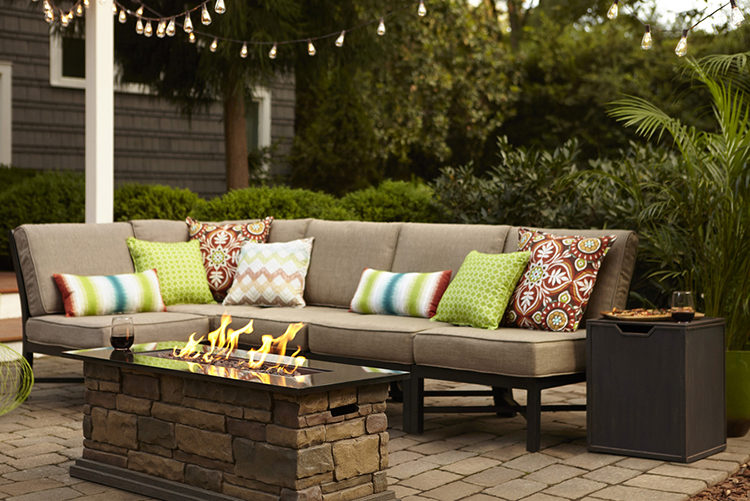I will admit that I am not the style maven of indoor…or outdoor furniture for that matter. In fact, I probably take furniture more for granted than anyone else. Take my home recliner for instance. I come in, plop down in it, drop a few things in its cracks, scratch on it with anything in my hand, and (try not to shutter) get up out of it sometimes without putting the foot stool thingee down. So why then would I care to write about furniture of any kind? Because despite my personal practices, I know how important it is. It is even more important when you have only a few pieces, thereby giving them more wear and tear than most people would. Thus is the life of a tiny houser with…well, almost anything! So recently I had a thought inspired by an article I read some time ago. Why not use outdoor fabric for indoor furniture?
A good introduction to outdoor fabrics can be found at your local big box hardware store. In my region it is Lowe’s and their garden section has a number of seat cushions and “conversation sets” that are largely upholstered with olefin fiber, which is a synthetic fiber made from polypropylene or polyethylene. It is strong, keeps it color in the harshest of environmental conditions, and is resistant to staining, mildew, abrasion, and sunlight.

More sophisticated fabrics are available though and textile designers like LULUDK, Scalamandre, and Holly Hunt. All three have outstanding examples of unique textiles that don’t look anything like an outdoor fabric. So why bring the outdoors in? Because life doesn’t stay outdoors.
When we were living in our first tiny house we were still in the process of cultivating our land as well as starting a small farmstead. Daily I would come in with dried mud on my dungarees, paint or caulk on my tshirts, and, of course, sweat stains all over. Not exactly the proper conditions for a wool blend tweed loveseat. A year later we had a baby (and all the interesting stains that can come with them) and again were faced with what to do about un-kid friendly furniture. If only then I had thought about an outdoor fabric for indoor upholstering. It would have given us stain resistance, durability, and comfort, to boot!
So what are outdoor fabrics?
Made from a wide variety of synthetic fibers, polyester, acrylic, and even cotton blends, outdoor fabrics are woven textiles that undergo chemical treatment during manufacturing. Because of this they can repel water and resist soiling and rot while also stopping mildew growth. Some of the more popular include:
- Solution-dyed 100% acrylic: This fabric holds up well to the sun, repels water efficiently, and doesn’t fade easily because the acrylic threads are dyed before they’re woven.
- Acrylic-coated 100% polyester: This fabric option is woven and then dipped into an acrylic coating. It’s a water resistant, acrylic-coated polyester fabrics, best used to make boat and car protectors.
- Acrylic-coated polyester-cotton blends: A man-made and natural fiber blend, it is both attractive and durable.
- Vinyl-coated cotton and vinyl-laminated polyester: Often used for sails, large canopies and commercial awnings, this slick, glossy fabric is waterproof and fire-resistant.
Perhaps though, what is best about outdoor fabrics is that as they grow in popularity they continue to grow in style with more prints, colors, and textures, being offered. Outdoor upholstery is an intelligent choice for the tiny house lifestyle because of its high performance ability that protect and make the most of the more casual and multifunctional tiny house spaces.
By Andrew M. Odom for the [Tiny House Blog]
Title photograph by Philip Greenspun

I used a very tough mossy green synthetic suede type fabric from thrift shop blackout curtains to cover my dinette seat cushions and it’s lasted amazingly well for almost 10 years. I also made a cover for the cushion out of the same material that just slips over the top with a minimal elasticised closure on the bottom, kind of like a fitted shower cap. This cover gets most of the wear and tear and can be taken off and washed easily, leaving the cover that requires more work to replace intact. If I’d had more fabric I’d have made another cover. This stuff is amazing, spill resistant and most importantly in my area, doesn’t get spruce and pine needles stuck in it. When the slipcover wears out I’ll get several more years out of the “real” cover. You can also make different slipcovers for different seasons or just for a change now and then without having to bother with new upholstery on the seats.
I’ve got different, inversely related, idea for you, Andrew, which would also make a good article — using outdoor furniture for the inside. Outdoor or patio furniture as it’s also called, is often much cheaper than indoor furniture, can be just as comfortable, and is often built to be more durable, especially the iron and heavy wooden furniture. It’s also offered at deep discounts in the off-season. It can provide an interesting, eclectic design element for a tiny interior. Think painted, wrought-iron table and chairs, hammock (a practical sleeping solution, too), even a park bench as sofa. The downside might be weight, but you don’t need a lot.
These materials give a lot of great comfort. I think they could be used for garden, terrace, living room and elsewhere. They look great. I wonder whether they are expensive?